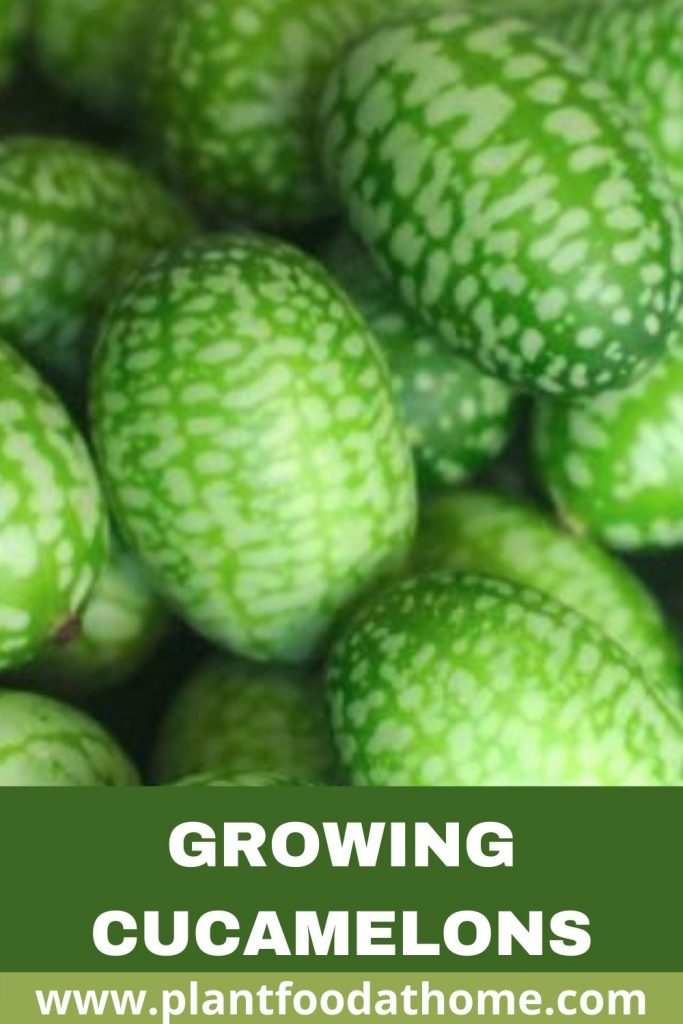Have you heard of cucamelons, the tiny-looking cucumbers that look like baby watermelons? Their small but perfect size makes them super cute to look at and they make a very tasty snack. Cucamelons are rare to find in grocery stores, and if you do, they’re quite pricey. So it is well worth growing cucamelons in your vegetable garden at home. Read on to find out how to grow cucamelons including planting, caring for them, and harvesting.
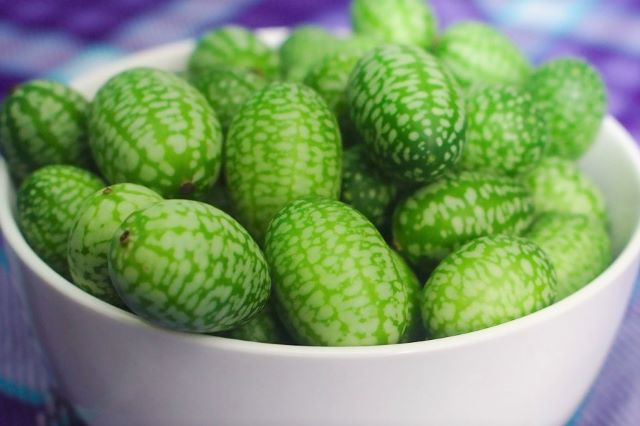
Table of Contents
- Cucamelon Plant Profile
- Quick Guide to Planting Cucamelons
- Ideal Growing Conditions for Cucamelons
- Growing Cucamelons from Seed
- Planting Cucamelons in the Garden
- Cucamelon Pollination
- Collecting Cucamelon Seeds for Next Seasons Growing
- Overwintering Cucamelon Plants
- Harvesting Cucamelons
- Storing Cucamelons
- Cucamelon Recipes
- Pests and Disease
- Conclusion
- Recommended Products
Cucamelon Plant Profile
Cucamelon, also known as Melothria Scabra, is under the larger cucumber family called Cucurbitaceae. This plant has been domesticated even before Western colonization of the Americans began. It is native to Mexico and Central America, where it is called Sandita which means little watermelon. Its other names include mouse melon, Mexican sour gherkin, Mexican miniature watermelon, Mexican sour cucumber, and pepquinos.
Cucamelon is technically a perennial plant but often grown as an annual vine during the warmer seasons. You can buy cucamelon seeds here.
The cucamelon vine produces one-inch fruits that are about the size of grapes and tastes like cucumbers with a hint of citrus similar to lime.
These plants can be slow-growing to begin with but once they get going, they will eventually grow up to 9.8 ft (3 meters) if grown in ideal conditions.
Cucamelon plants are monoecious which means that they produce both male and female flowers. The flowers are small and yellow in color. The fruit develops at the bottom of the female flower.
Quick Guide to Planting Cucamelons
- Cucamelon seeds can be started indoors 4 weeks before the growing season in spring to monitor the soil humidity.
- Plant cucamelons outdoors after all the danger of frost has passed.
- Grow cucamelons in full sun for thriving plants.
- Once established, cucamelons can tolerate some drought-like conditions but will do best with regular watering.
- Fertilize lightly once or twice during the growing season.
- Provide a trellis or support for the vine.
- Regular harvesting of cucamelons will promote fruit production.
Ideal Growing Conditions for Cucamelons
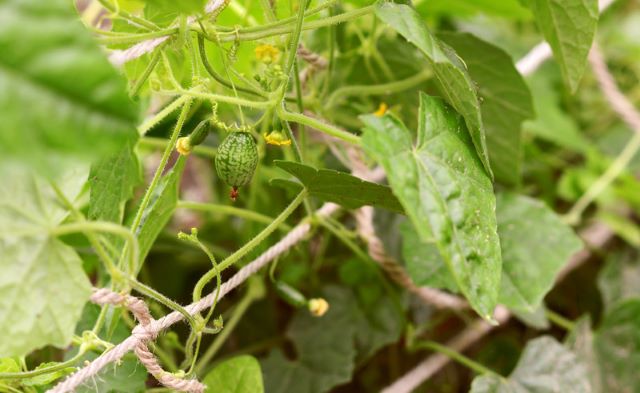
Climate for Growing Cucamelons
Cucamelons thrive in warm and temperate conditions when the average air temperatures are 72-82°F (22-28°C). They are sensitive to cold climates and frost so aim to plant them after the danger of all frost has passed.
Soil Requirements for Growing Cucamelons
Cucamelons can be planted in most soil types as long as it’s well-draining. But for the best results, the soil should be rich and nutritious, organic matter and compost. To help increase soil fertility, amend the soil with aged manure and homemade compost.
Sun Requirements for Cucamelon
Cucamelons need six to eight hours or more of direct sunlight each day. So plan to plant them in a sunny position in the garden.
Water Requirements for Cucamelon
Cucamelons need about an inch of water each week. Drip irrigation is ideal to help avoid watering the leaves. Instead, water the soil around the plant. For best results, water cucamelon plants when the topsoil becomes dry. Soil should still be moist about an inch below the surface. You can check this by scratching the surface and using a finger to check or a water monitor here.
Fertilizer for Cucamelon Plants
If the soil is fertile, cucamelon plants should have everything they need for a good start. You can fertilize once the cucamelon plant begins to flower, with an organic edible plant fertilizer.
Growing Cucamelons from Seed
Cucamelons can be given a head start to the growing season by starting seeds indoors 4 weeks before your last expected frost. Or you can plant them directly into the garden when all chance of frost has passed.
Prepare seedling trays or pots with an organic seed raising mix. Cucamelons need warm soil around 70-75°F (21-24°C). So if you are growing them indoors, consider using a seedling heat mat to help them to germinate.
Plant the seeds 1/2 inch (12mm) deep, about 3-4 seeds per pot. Place them in a sunny window or put them under a grow light. ( You can read more about How to Start Vegetable Seedlings Under Grow Lights here)
Keep the soil moist.
You can cover the trays or pots with a plastic wrap or tray cover to help keep the soil moisture. Germination takes 7 to 14 days but sometimes up to four weeks. Once the seeds have germinated, remove the cover to allow air circulation.
When the seedlings start to emerge and grow two sets for true leave, start thinning them to 1 plant per pot to promote growth. At about 2 inches tall, 3 to 5 weeks from starting the seeds, begin the process of hardening them off, which means they need to be slowly exposed to outdoor conditions. Hardening off should be done 7 to 14 days before planting them outdoors in containers or in the garden. You can read more about the process of hardening off in our article: Hardening Off Seedlings.
Planting Cucamelons in the Garden
Because cucamelons love warmth, look for a place in your garden that gets full sun and protection from strong winds. Carefully pop the plant out from its tray or pot and plant them at least 2 feet (60cm) apart from each other.
Gently firm the soil and water them after planting. As their vines are delicate, it’s best to use a trellis or a wire fence to support the vines. This will also keep the fruit off the ground where it can otherwise rot. Growing on a trellis also helps for ease of harvesting without damaging the vines. You might like to see our DIY Trellis here.
Cucamelon plants grown in containers also need support to climb too.
While out walking one afternoon, I noticed the cucamelon vine in the below photo growing over another non-edible vine covering a front yard fence. So as you can see, cucamelons vines will happily grow over any structure that gives them something to climb up.
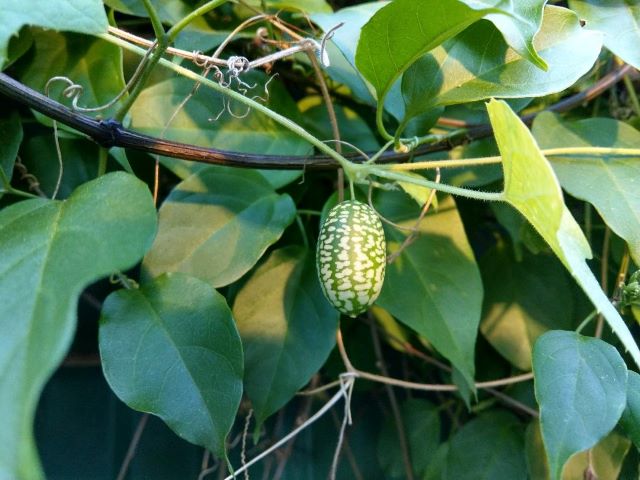
Cucamelon Pollination
Cucamelon vines produce both male and female flowers and they rely on insect pollination. This is usually in the form of bees but can also include other beneficial insects.
So it’s a good idea to have flowering plants nearby to attract pollinators to your garden. There are many plants that will do this, for example, nasturtium or African blue basil are wonderful plants for attracting bees.
You can also increase pollination by hand pollinating the cucamelon flowers yourself. This is easy to do, once you know-how.
The male flowers grow on a long, thin stem while the female flowers have an immature fruit growing from the base. Simply take a small paintbrush or similar, and gently brush inside the male flower before brushing inside the female flower. This will transfer the pollen from male to female flowers for successful pollination and a bigger harvest of cucamelons. But I would only hand pollinate if pollination is not occurring on its own. Hand pollinating these little and prolific flowers will likely be time-consuming for a tiny reward.
Collecting Cucamelon Seeds for Next Seasons Growing
At the end of the growing season, you can leave some cucamelon fruit on the vine until they are overripe, soft, and yellow. Then harvest them to scrape out the seeds, rinse and dry them off, and store them in a paper seed sleeve. Store for future use or share them with friends and family.
Overwintering Cucamelon Plants
As the cucamelon plant grows, it develops tubers underground. In cooler climates, when the weather turns from warm to much colder, the cucamelon tubers can be dug out of the ground and overwintered in dry to slightly moist potting soil or sand in a dry location to see out the winter.
Then as the weather warms up again, the cucamelon tuber can be planted into pots to re-sprout before transplanting back out into the garden for another season of growing cucamelons.
Harvesting Cucamelons
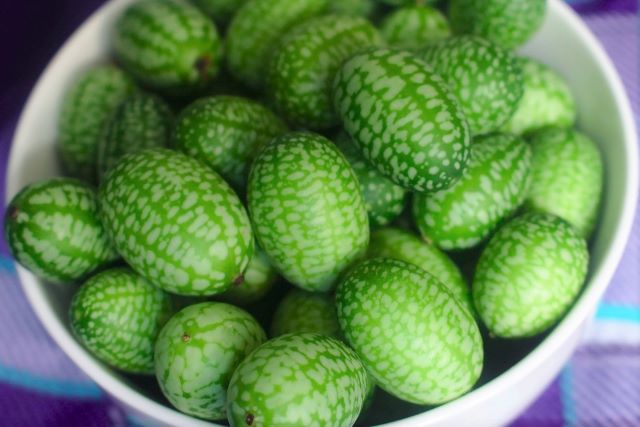
Cucamelons normally start to produce fruits at 60-75 days. This generally coincides with when the weather is warm in summer.
After 2 to 3 weeks of flowering, the fruit will start to appear at the base of the female flower. They are ready for harvest when the cucamelon fruit is about 1.5 inches (4cm) in size or like the size of a large grape. They should be firm and have a bright green color.
Harvesting cucamelons is like harvesting cucumbers. They easily pop off however, to avoid damaging the vine as they are quite sensitive, it’s best to cut them rather than pulling them off.
If you harvest cucamelons often you will be helping to promote fruit production. Also, once they start fruiting, they grow quickly, so make sure to check them every other day because if they grow larger, they become seedier, turn a yellowish color, and won’t taste very nice to eat.
Storing Cucamelons
Keep cucamelons stored in the refrigerator to prolong their shelf life. They are best eaten in around 10 days.
Aside from eating them fresh off the vine, cucamelons are popular in salads and salsas. They are also great for pickling and canning too.
Cucamelon Recipes
If you’re looking for ways to use your cucamelons in a recipe, here a few to try:
Cucamelon Pickles – from Love and Olive Oil
Cucamelon Salad – from Feathers in the Woods
Peach Cucamelon Salsa – from All Recipes
Pests and Disease
Cucamelons are fairly pest resistant compared to other vining plants of their kind.
Powdery mildew can affect cucamelon plants and can be sprayed with a DIY milk spray here.
And aphids are a common pest to affect these plants. Often a hose with water will get rid of them.
To help prevent pests and diseases, cucamelon plants need good air circulation.
Using organic pesticides like citrus oils or insecticidal soaps can be beneficial if pests or disease do become a problem.
Conclusion
Who can resist these cute mouse melon cucamelons? By growing your own cucamelons you can harvest and eat them fresh whenever you please. Happy growing!
Recommended Products
- Cucamelon Seeds
- Soil pH, Water and Light Monitor
- Organic Edible Plant Fertilizer
- Organic Seed Raising Potting Mix
- Seedling Heat Mat
- Grow Lights
Further Reading:
- How to Grow Cucumbers: Planting, Growing and Harvesting
- Why are Burpless Cucumbers Called Burpless?
- 7 Reasons Why Your Cucumbers Are Turning Yellow
- How to Grow Luffa Gourds for Loofah Sponges
- Watermelon Plant Dying? Causes and Solutions
- Kiwano Melon: Grow African Horned Melon and Eat the Fruit
- A Guide to Harvesting Ripe Cantaloupes
